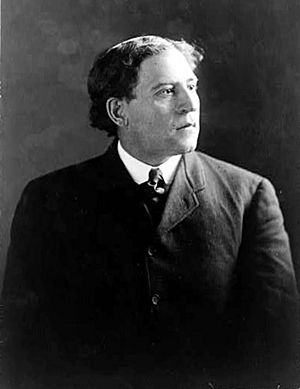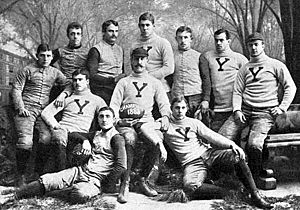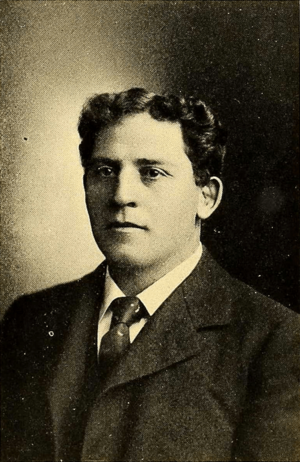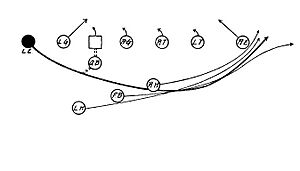Amos Alonzo Stagg facts for kids

Stagg in 1906
|
|
| Biographical details | |
|---|---|
| Born | August 16, 1862 West Orange, New Jersey |
| Died | March 17, 1965 (aged 102) Stockton, California |
| Playing career | |
| Football | |
| 1885–1889 | Yale |
| 1892 | Chicago |
| Position(s) | End, halfback |
| Coaching career (HC unless noted) | |
| Football | |
| 1890–1891 | Williston Seminary (MA) |
| 1890–1891 | YMCA (MA) |
| 1892–1932 | Chicago |
| 1933–1946 | Pacific (CA) |
| 1947–1952 | Susquehanna (associate HC) |
| 1953–1958 | Stockton College (ST) |
| Basketball | |
| 1920–1921 | Chicago |
| Baseball | |
| 1893–1905 | Chicago |
| 1907–1913 | Chicago |
| Track | |
| 1896–1913 | Chicago |
| 1914–1928 | Chicago |
| Administrative career (AD unless noted) | |
| 1892–1933 | Chicago |
| Head coaching record | |
| Overall | 314–199–35 (college football) 14–6 (basketball) 266–158–3 (baseball) |
| Bowls | 0–1 |
| Accomplishments and honors | |
| Championships | |
| Football 2 National (1905, 1913) 7 Western / Big Ten (1899, 1905, 1907–1908, 1913, 1922, 1924) 5 NCAC (1936, 1938, 1940–1942) |
|
| Awards | |
| Football All-American, 1889 AFCA Coach of the Year (1943) |
|
| College Football Hall of Fame Inducted in 1951 (profile) |
|
| Basketball Hall of Fame Inducted in 1959 (profile) |
|
Amos Alonzo Stagg (born August 16, 1862 – died March 17, 1965) was a very important American athlete and college coach. He was known for coaching many sports, especially American football. He coached football at Springfield College (1890–1891), the University of Chicago (1892–1932), and the College of the Pacific (1933–1946). His teams won 314 games, lost 199, and tied 35.
His Chicago Maroons football teams were undefeated in 1905 and 1913. These teams are recognized as national champions. Stagg also coached basketball for one season at Chicago (1920–1921). He was also the head baseball coach for nineteen seasons (1893–1905, 1907–1913).
At the University of Chicago, Stagg started annual basketball tournaments and track meets for high school teams. These events brought top young athletes from all over the United States.
Stagg played football as an end at Yale University. He was chosen for the very first All-America Team in 1889. He was one of the first people inducted into the College Football Hall of Fame in 1951, both as a player and a coach. He was the only person honored in both roles for many years. Stagg also helped develop basketball into a five-player game. This idea helped his football players stay in shape during the winter. He was also inducted into the Basketball Hall of Fame in 1959.
Stagg believed that sports and religious faith were connected. This belief was very important to him throughout his life.
Contents
Early Life and College Years
Amos Alonzo Stagg was born in West Orange, New Jersey. He grew up in a neighborhood with many Irish Americans. He later attended Phillips Exeter Academy, a well-known school.
Playing Sports at Yale
Stagg went to Yale University in New Haven, Connecticut. While there, he studied religion. He was also part of a fraternity called Psi Upsilon. He was also a member of a secret society called "The Order of the Skull and Bones."
Baseball Skills
Stagg was a talented pitcher for the Yale baseball team. He was offered a chance to play for six different professional baseball teams, but he turned them down. Even so, he made a lasting impact on the game by inventing the batting cage.
Football Achievements
Stagg played on the 1888 Yale football team. He was an end on the first-ever All-America Team in 1889.
Time at Springfield College
After Yale, Stagg decided not to become a religious leader. Instead, he earned a master's degree in physical education from Young Men's Christian Training School in 1891. This school is now known as Springfield College.
Basketball's Beginning
Basketball was invented in 1891 by James Naismith, a teacher at the YMCA School in Springfield. On March 11, 1892, Stagg, who was an instructor there, played in the first public basketball game. About 200 people watched the student team beat the faculty team 5–1. Stagg scored the only basket for his team. He helped make basketball popular as a game played with five players on each team.
Stagg's Coaching Career
Stagg became the first paid football coach at Williston Northampton School, a high school, in 1890. This was his first time getting paid to coach football. He worked there one day a week while also coaching full-time at Springfield College.
He then became the head football coach and director of physical education at the University of Chicago. He coached there for a long time, from 1892 to 1932. Eventually, the university president, Robert Maynard Hutchins, felt Stagg was too old to keep coaching, so he had to leave.
Even at 70 years old, Stagg continued coaching. He moved to the College of the Pacific in Stockton, California. He led the Tigers for 14 seasons, from 1933 to 1946. One of his players at Pacific was Wayne Hardin, who later became a famous coach himself.
In 1924, Stagg was a coach for the U.S. Olympic Track and Field team at the 1924 Summer Olympics in Paris. He even played himself in the movie Knute Rockne, All American in 1940. From 1947 to 1952, he coached with his son, Amos Alonzo Stagg, Jr., at Susquehanna University. Stagg's last coaching job was as a kicking coach at Stockton College. He retired at the age of 96 and passed away six years later. People often called him "The Grand Old Man of Football."
Healthy Lifestyle
Stagg was a vegetarian. He also did not allow his players to drink alcohol or smoke. In 1907, he made his Chicago football team follow a strict vegetarian diet. This was talked about a lot in newspapers and health magazines at the time.
Stagg's Family Life
Amos Alonzo Stagg married Stella Robertson on September 10, 1894. They had three children: two sons, Amos Jr. and Paul, and a daughter, Ruth. Both of his sons played quarterback for their father at the University of Chicago. They both later became college football coaches too. In 1952, Stagg's granddaughter, Barbara Stagg, started coaching a high school girls' basketball team in Slatington, Pennsylvania.
Stagg's Lasting Impact
Many places and awards are named after Amos Alonzo Stagg because of his important contributions.
- Two high schools are named after him: one in Palos Hills, Illinois, and another in Stockton, California.
- An elementary school in Chicago, Illinois, is also named in his honor.
- The NCAA Division III National Football Championship game, played in Salem, Virginia, is called the Stagg Bowl.
- The athletic stadium at Springfield College is named Stagg Field.
- The football field at Susquehanna University is named Amos Alonzo Stagg Field, honoring both him and his son.
- The old football field at the University of Chicago was also called Stagg Field.
- At the University of the Pacific in Stockton, California, a campus street is called Stagg Way. Their football and soccer stadium was renamed Amos Alonzo Stagg Memorial Stadium in 1988.
- Phillips Exeter Academy has a field and a statue named for him.
- A field in West Orange, New Jersey, is also named after him.
- The Amos Alonzo Stagg Award is given to people or groups who have done outstanding work to help football.
- The winner of the Big Ten Football Championship Game, which started in 2011, receives the Stagg Championship Trophy.
In 1979–1980, students and teachers at the College of William and Mary formed the Amos Alonzo Stagg Society. They were against a plan to make their college football team a "big-time" program again after a past scandal. The society helped stop a major expansion of the football stadium.
You can find collections of Amos Alonzo Stagg's papers at the University of Chicago Library and the University of the Pacific Library. There is also a long hike called the Alonzo Stagg 50/20 Hike that goes through Arlington, Virginia, Washington, DC, and Maryland.
A giant sequoia tree in California, the fifth largest tree in the world, is named the Stagg Tree in honor of Amos Alonzo Stagg.
The Stagg Bowl Football Game
The Amos Alonzo Stagg Bowl is the final game of the NCAA Division III Football Championship Tournament. This game has been played every year since 1973.
The Stagg Bowl actually started in 1969, before the D-III national championship existed. Back then, it was one of two bowl games for college teams. In 1973, when the NCAA created the D-III national championship, the Stagg Bowl became the name for that final game.
The first 10 Stagg Bowls (1973-1982) were played in Phenix City, Alabama. Wittenberg University won the first game 41–0. The game then moved to Kings Island, Ohio, for 1983 and 1984. Augustana College won two of its four straight NCAA titles there.
The Stagg Bowl returned to Phenix City for five more years, then spent three seasons in Bradenton, Florida. Since 1993, the Stagg Bowl has been played in Salem, Virginia. The University of Mount Union has won many championships there, setting a record with 13 NCAA Division III football national titles.
Stagg's Football Innovations
Amos Alonzo Stagg introduced many new ideas to American football. Here are some of the things he helped create or popularize:
- Ends-back formation (1890)
- Reverse play (1890)
- 7–2–2 defense (1890)
- The first indoor football game (1891)
- The first book on football with diagrams (1893, with Henry Williams)
- The first intersectional game (1894)
- The center snap (1894)
- The onside kick (1894)
- The huddle (1896)
- The quick kick (1896)
- The Short punt (1896)
- The spiral snap (1896)
- The line shift (1897)
- The placement kick (1897)
- The lateral pass (1898)
- The tackling dummy (1899)
- The unbalanced line (1900)
- The Notre Dame Box (1905)
- varsity letters (1906)
- The Statue of Liberty play (1908)
- uniform numbers (1913)
- The T formation
- The forward pass
- The man in motion
- The sleeper play
- The quarterback keeper
- The delayed buck
- The linebacker position
- Hip pads
- Numbering plays
- Padded goalposts
- The end-around
Stagg's Coaching Tree
Many of Stagg's players and assistant coaches went on to become head football coaches at other colleges and universities. This shows how much he influenced the sport and the people in it.
- Players who became head coaches:
- W. J. Keller: Vanderbilt (1893)
- Art Badenoch: Rose Poly (1906), New Mexico A&M (1910–1913)
- William Boone (American football): Hillsdale (1906)
- Mark Catlin Sr.: Iowa (1906–1908), Lawrence (1909–1918, 1924–1927)
- Maurice Gordon Clarke: Texas (1899), Western Reserve (1900), Washington (1901)
- Paul Des Jardien: Oberlin (1916)
- Campbell Dickson: Beloit (1928), Hamilton (1942)
- Ivan Doseff: Kalamazoo (1910), Iowa State Normal (1919–1920), Luther (1921–1922)
- Daniel Dougherty: Grinnell (1909)
- Shorty Ellsworth: Colorado Mines (1904–1907)
- A. A. Ewing: Northwestern (1894)
- J. C. Ewing: Colorado College (1900–1901), Baylor (1902)
- Frederick Feil: Wabash (1901)
- Sherman W. Finger: Cornell (IA) (1907–1923)
- Charles Firth: VPI (1897), Hillsdale (1913)
- Charles G. Flanagan: Morningside (1902)
- Ralph C. Hamill: Centre (1900)
- Jesse Harper: Alma (1906–1907), Wabash (1909–1912), Notre Dame (1913–1917)
- James R. Henry: DePauw (1902), Vanderbilt (1903)
- Frank E. Hering: Notre Dame (1896–1898)
- A. C. Hoffman: Ripon (1911), Tulane (1913)
- Tony Hinkle: Butler (1926, 1935–1941, 1946–1969), Great Lakes Navy (1942–1943)
- A. F. Holste: Wisconsin–Whitewater (1900), Denison (1902), Rose Poly (1903), Fairmount (1904), Hastings (1908–1910?, 1922–1925)
- Harold Iddings: Miami (OH) (1909–1910), Simpson (1911–1913), Otterbein (1916), Penn (IA) (1921)
- Thomas Kelley: Muhlenberg (1911–1913), Missouri Mines (1914), Alabama (1915–1917), Idaho (1920–1921), Missouri (1922)
- Walter S. Kennedy: Albion (1904–1920)
- E. Pratt King: Delaware (1907)
- Elmer A. Lampe: Carleton (1932–1933)
- Lester Larson: Texas A&M (1907), Louisville (1912–1913)
- Fred Luehring: Ripon (1906–1909)
- Walter E. Marks: Indiana State (1927–1930, 1933–1941, 1946–1948)
- Hal Mefford: Rose Poly (1916), Kendall (1917)
- Ned Merriam: Texas A&M (1908)
- Theron W. Mortimer: Colorado (1900), Alma (1901)
- Nelson Norgren: Utah (1914–1917)
- Norman C. Paine: Baylor (1913), Arkansas (1917–1918), Iowa State (1920)
- Ed Parry: Oklahoma A&M (1907–1908)
- Alfred W. Place: Buchtel (1903)
- Raymond L. Quigley: Northern Normal and Industrial (1910–1911), Arizona (1912)
- Charles M. Rademacher: Idaho (1915), St. Louis (1917, 1919–1920)
- Joseph Raycroft: Lawrence (1894), Stevens Point Normal (1895–1896)
- Clarence W. Russell: West Virginia (1907), Colorado Mines (1908), New Mexico A&M (1914–1916)
- A. G. Scanlon: Purdue (1918–1920)
- Lewis D. Scherer: Nebraska State Normal (1907–1908), Baker (1910–1912)
- Walter Steffen: Carnegie Tech (1914–1932)
- Herman Stegeman: Beloit (1915), Monmouth (1916–1917), Georgia (1920–1922)
- John Webster Thomas: Haskell (1927–1928)
- John F. Tobin: Tulane (1905)
- Mysterious Walker: Utah Agricultural (1907-1908), Williams (1917), New York Agricultural (1919), DePauw (1921), Drury (1924-1925), Wheaton (1936-1939)
- Horace Whiteside: Earlham (1914–1916)
- Sherburn Wightman: Massillon Tigers (1906), All-Massillons (1907), Dover Giants (1908)
- Ralph H. Young: DePauw (1915), Kalamazoo (1916–1917, 1919–1922), Michigan State (1923–1927)
- Assistant coaches who became head coaches:
- John Anderson: Knox (1917), Rice (1918)
- Hugo Bezdek: Oregon (1906, 1913–1916), Arkansas (1908–1912), Penn State (1918–1929), Cleveland Rams (1937–1938)
- Fritz Crisler: Minnesota (1930–1931), Princeton (1932–1937), Michigan (1938–1947)
- Ira Davenport: Columbia (IA) (1920–1921)
- Leo DeTray: Ole Miss (1912), Knox (1915–1916)
- Clarence Herschberger: Lake Forest (1902–1904)
- Harlan Page: Butler (1920–1925), Indiana (1926–1930), College of Idaho (1936–1937)
- James M. Sheldon: Indiana (1905–1913)
- Frederick A. Speik: Purdue (1908–1909)
- Amos Alonzo Stagg Jr.: Susquehanna (1935–1954)
- Paul Stagg: Moravian (1934–1936), Springfield (1937–1940), Worcester Tech (1941–1946), Pacific (1947–1960)
- Wayne Hardin: Navy (1959–1964), Philadelphia Bulldogs (1966), Temple (1970–1982)
- Larry Siemering: Pacific (1947–1950), Arizona State (1951), Calgary Stampeders (1954)
Coaching Records
College Football Coaching Record
| Year | Team | Overall | Conference | Standing | Bowl/playoffs | AP# | |||
|---|---|---|---|---|---|---|---|---|---|
| YMCA (Independent) (1890–1891) | |||||||||
| 1890 | YMCA | 5–3 | |||||||
| 1891 | YMCA | 5–8–1 | |||||||
| YMCA: | 10–11–1 | ||||||||
| Chicago Maroons (Independent) (1892–1895) | |||||||||
| 1892 | Chicago | 1–4–2 | |||||||
| 1893 | Chicago | 6–4–2 | |||||||
| 1894 | Chicago | 11–7–1 | |||||||
| 1895 | Chicago | 7–3 | |||||||
| Chicago Maroons (Western Conference / Big Ten Conference) (1896–1932) | |||||||||
| 1896 | Chicago | 11–2–1 | 3–2 | 4th | |||||
| 1897 | Chicago | 8–1 | 3–1 | 2nd | |||||
| 1898 | Chicago | 9–2–1 | 3–1 | 2nd | |||||
| 1899 | Chicago | 12–0–2 | 4–0 | 1st | |||||
| 1900 | Chicago | 7–5–1 | 2–3–1 | 6th | |||||
| 1901 | Chicago | 5–5–2 | 0–4–1 | 9th | |||||
| 1902 | Chicago | 11–1 | 5–1 | 2nd | |||||
| 1903 | Chicago | 10–2–1 | 4–1 | 4th | |||||
| 1904 | Chicago | 8–1–1 | 5–1–1 | 3rd | |||||
| 1905 | Chicago | 11–0 | 7–0 | 1st | |||||
| 1906 | Chicago | 4–1 | 3–1 | 4th | |||||
| 1907 | Chicago | 4–1 | 4–0 | 1st | |||||
| 1908 | Chicago | 5–0–1 | 5–0 | 1st | |||||
| 1909 | Chicago | 4–1–2 | 4–1–1 | 2nd | |||||
| 1910 | Chicago | 2–5 | 2–4 | 7th | |||||
| 1911 | Chicago | 6–1 | 5–1 | 2nd | |||||
| 1912 | Chicago | 6–1 | 6–1 | 2nd | |||||
| 1913 | Chicago | 7–0 | 7–0 | 1st | |||||
| 1914 | Chicago | 4–2–1 | 4–2–1 | 7th | |||||
| 1915 | Chicago | 5–2 | 4–2 | 3rd | |||||
| 1916 | Chicago | 3–4 | 3–3 | 5th | |||||
| 1917 | Chicago | 3–2–1 | 2–2–1 | 5th | |||||
| 1918 | Chicago | 0–6 | 0–5 | 10th | |||||
| 1919 | Chicago | 5–2 | 4–2 | 3rd | |||||
| 1920 | Chicago | 3–4 | 2–4 | 8th | |||||
| 1921 | Chicago | 6–1 | 4–1 | 2nd | |||||
| 1922 | Chicago | 5–1–1 | 4–0–1 | 1st | |||||
| 1923 | Chicago | 7–1 | 7–1 | 3rd | |||||
| 1924 | Chicago | 4–1–3 | 3–0–3 | 1st | |||||
| 1925 | Chicago | 3–4–1 | 2–2–1 | 7th | |||||
| 1926 | Chicago | 2–6 | 0–5 | 10th | |||||
| 1927 | Chicago | 4–4 | 4–4 | 5th | |||||
| 1928 | Chicago | 2–7 | 0–5 | 10th | |||||
| 1929 | Chicago | 7–3 | 1–3 | 7th | |||||
| 1930 | Chicago | 2–5–2 | 0–4 | 10th | |||||
| 1931 | Chicago | 2–6–1 | 1–4 | 8th | |||||
| 1932 | Chicago | 3–4–1 | 1–4 | 8th | |||||
| Chicago: | 244–111–27 | 115–74–12 | |||||||
| Pacific Tigers (Far Western Conference) (1933–1942) | |||||||||
| 1933 | Pacific | 5–5 | 3–2 | 3rd | |||||
| 1934 | Pacific | 4–5 | 2–2 | 4th | |||||
| 1935 | Pacific | 5–4–1 | 3–1 | 2nd | |||||
| 1936 | Pacific | 5–4–1 | 4–0 | 1st | |||||
| 1937 | Pacific | 3–5–2 | 3–1 | 2nd | |||||
| 1938 | Pacific | 7–3 | 4–0 | 1st | |||||
| 1939 | Pacific | 6–6–1 | 2–1 | 2nd | |||||
| 1940 | Pacific | 4–5 | 2–0 | 1st | |||||
| 1941 | Pacific | 4–7 | 3–0 | 1st | |||||
| 1942 | Pacific | 2–6–1 | 2–0 | 1st | |||||
| Pacific Tigers (Independent) (1943–1945) | |||||||||
| 1943 | Pacific | 7–2 | 19 | ||||||
| 1944 | Pacific | 3–8 | |||||||
| 1945 | Pacific | 0–10–1 | |||||||
| Pacific Tigers (Far Western Conference) (1946) | |||||||||
| 1946 | Pacific | 5–7 | 2–2 | T–2nd | L Optimist | ||||
| Pacific: | 60–77–7 | 30–9 | |||||||
| Total: | 314–199–35 | ||||||||
| National championship Conference title Conference division title or championship game berth | |||||||||
|
|||||||||
College Basketball Coaching Record
| Season | Team | Overall | Conference | Standing | Postseason | ||||
|---|---|---|---|---|---|---|---|---|---|
| Chicago Maroons (Big Ten Conference) (1920–1921) | |||||||||
| 1920–21 | Chicago | 14–6 | 6–6 | 8th | |||||
| Chicago: | 14–6 | 6–6 | |||||||
| Total: | 14–6 | ||||||||
See also
 In Spanish: Amos Alonzo Stagg para niños
In Spanish: Amos Alonzo Stagg para niños




